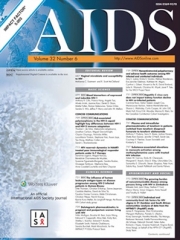Posted on June 01, 2017
Source: AIDS An Official International AIDS Society journal

Coronary artery endothelial dysfunction is present in HIV-positive individuals without significant coronary artery disease
Iantorno, Micaela; Schär, Michael; Soleimanifard, Sahar; Brown, Todd T.; Moore, Richard; Barditch-Crovo, Patricia; Stuber, Matthias; Lai, Shenghan; Gerstenblith, Gary; Weiss, Robert G.; Hays, Allison G
Objective: HIV-positive (HIV+) individuals experience an increased burden of coronary artery disease (CAD) not adequately accounted for by traditional CAD risk factors. Coronary endothelial function (CEF), a barometer of vascular health, is depressed early in atherosclerosis and predict future events but has not been studied in HIV+ individuals. We tested whether CEF is impaired in HIV+ patients without CAD as compared with an HIV-negative (HIV−) population matched for cardiac risk factors.
Design/methods: In this observational study, CEF was measured noninvasively by quantifying isometric handgrip exercise-induced changes in coronary vasoreactivity with MRI in 18 participants with HIV but no CAD (HIV+CAD−, based on prior imaging), 36 age-matched and cardiac risk factor-matched healthy participants with neither HIV nor CAD (HIV−CAD−), 41 patients with no HIV but with known CAD (HIV−CAD+), and 17 patients with both HIV and CAD (HIV+CAD+).
Results: CEF was significantly depressed in HIV+CAD− patients as compared with that of risk-factor-matched HIV−CAD− patients (P < 0.0001) and was depressed to the level of that in HIV− participants with established CAD. Mean IL-6 levels were higher in HIV+ participants (P< 0.0001) and inversely related to CEF in the HIV+ patients (P = 0.007).
Conclusion: Marked coronary endothelial dysfunction is present in HIV+ patients without significant CAD and is as severe as that in clinical CAD patients. Furthermore, endothelial dysfunction appears inversely related to the degree of inflammation in HIV+ patients as measured by IL-6. CEF testing in HIV+ patients may be useful for assessing cardiovascular risk and testing new CAD treatment strategies, including those targeting inflammation.